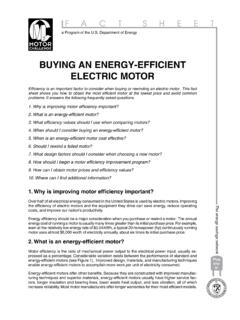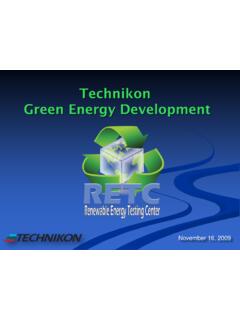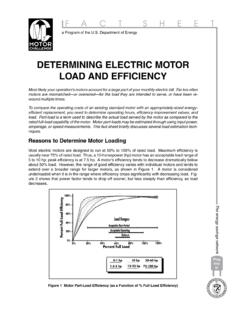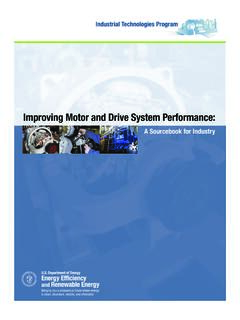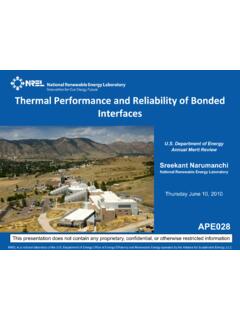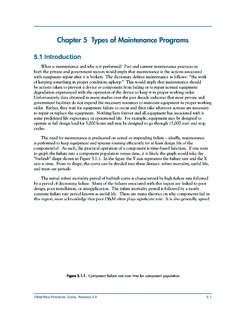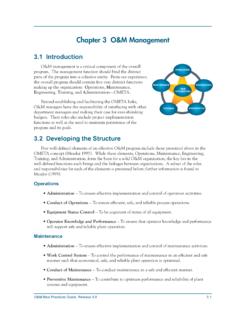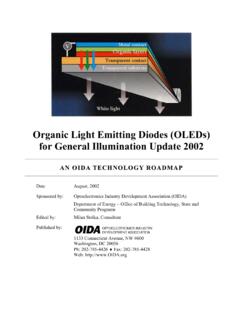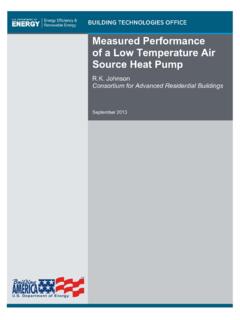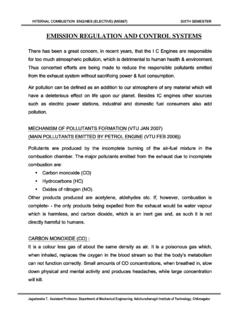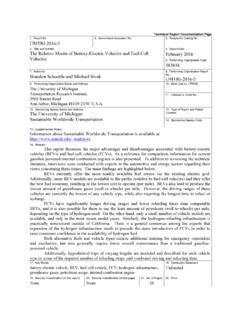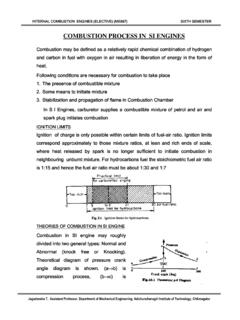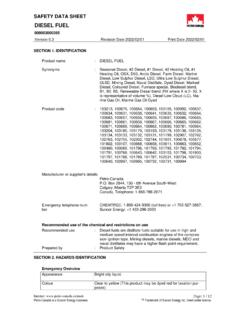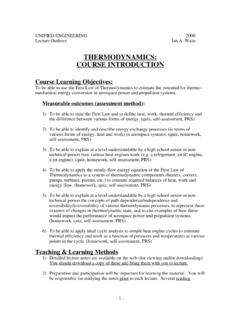Transcription of MODULE 3: HYDROGEN USE IN INTERNAL - Energy
1 HYDROGEN fuel Cell Engines MODULE 3: HYDROGEN USE IN INTERNAL combustion ENGINES CONTENTS HYDROGEN COMBUSTIVE PROPERTIES OF AIR/ fuel PRE-IGNITION PROBLEMS AND fuel DELIVERY THERMAL engine IGNITION CRANKCASE THERMAL POWER HYDROGEN GAS CURRENT HYDROGEN fuel Cell Engines and Related Technologies: Rev 0, December 2001 HYDROGEN fuel Cell Engines MODULE 3: HYDROGEN USE IN INTERNAL combustion ENGINES OBJECTIVES At the completion of this MODULE , the technician will understand: the combustive properties of HYDROGEN that relate to its use as a combustive fuel the air/ fuel ratio of HYDROGEN fuel mixtures and how it compares to other fuels the types of pre-ignition problems encountered in a HYDROGEN INTERNAL combustion engine and their solutions the type of ignition systems that may be used with HYDROGEN INTERNAL combustion engines crankcase ventilation issues that pertain to HYDROGEN use in an INTERNAL combustion engine the thermal efficiency of HYDROGEN INTERNAL combustion engines the type of emissions associated with HYDROGEN INTERNAL combustion engines the power output of HYDROGEN INTERNAL combustion engines the effect of mixing HYDROGEN with other hydrocarbon fuels HYDROGEN
2 fuel Cell Engines and Related Technologies: Rev 0, December 2001 HYDROGEN fuel Cell Engines MODULE 3: HYDROGEN USE IN INTERNAL combustion ENGINES PAGE 3-1 Key Points & Notes HYDROGEN Engines The small number of vehicles using HYDROGEN INTERNAL combustion engines (HICE) makes it difficult to explain how to repair them. Therefore, this section does not serve as a repair manual, but as an outline describing the operation of a HYDROGEN engine and its major components, its benefits, drawbacks and how components can be modified or re-designed to reduce the drawbacks. In general, getting an INTERNAL combustion engine to run on HYDROGEN is not difficult.
3 Getting an INTERNAL combustion engine to run well, however, is more of a challenge. This section points out the key components and techniques required to make the difference between a HYDROGEN engine that just runs and one that runs well. The earliest attempt at developing a HYDROGEN engine was reported by Reverend W. Cecil in 1820. Cecil presented his work before the Cambridge Philosophical Society in a paper entitled On the Application of HYDROGEN Gas to Produce Moving Power in Machinery. The engine itself operated on the vacuum principle, in which atmospheric pressure drives a piston back against a vacuum to produce power. The vac-uum is created by burning a HYDROGEN -air mixture, allowing it to expand and then cool.
4 Although the engine ran satisfac-torily, vacuum engines never became practical. Figure 3-1 HYDROGEN -Powered 1965 Cobra Replica HYDROGEN fuel Cell Engines and Related Technologies: Rev 0, December 2001 HYDROGEN fuel Cell Engines MODULE 3: HYDROGEN USE IN INTERNAL combustion engine PAGE 3-2 Key Points & Notes Sixty years later, during his work with combustion engines in the 1860s and 1870s, N. A. Otto (the inventor of the Otto cycle) reportedly used a synthetic producer gas for fuel , which probably had a HYDROGEN content of over 50%. Otto also experimented with gasoline, but found it dangerous to work with, prompting him to return to using gaseous fuels.
5 The development of the carburetor, however, initiated a new era in which gasoline could be used both practically and safely, and interest in other fuels subsided. HYDROGEN has since been used extensively in the space pro-gram since it has the best Energy -to-weight ratio of any fuel . Liquid HYDROGEN is the fuel of choice for rocket engines, and has been utilized in the upper stages of launch vehicles on many space missions including the Apollo missions to the moon, Skylab, the Viking missions to Mars and the Voyager mission to Saturn. In recent years, the concern for cleaner air, along with stricter air pollution regulation and the desire to reduce the dependency on fossil fuels have rekindled the interest in hy-drogen as a vehicular fuel .
6 Figure 3-2 HYDROGEN -Powered Pickup HYDROGEN fuel Cell Engines and Related Technologies: Rev 0, December 2001 HYDROGEN fuel Cell Engines MODULE 3: HYDROGEN USE IN INTERNAL combustion ENGINES PAGE 3-3 Key Points & Notes Combustive Properties of HYDROGEN The properties of HYDROGEN are detailed in Section 1. The properties that contribute to its use as a combustible fuel are its: wide range of flammability low ignition Energy small quenching distance high autoignition temperature high flame speed at stoichiometric ratios high diffusivity very low density Wide Range of Flammability HYDROGEN has a wide flammability range in comparison with all other fuels.
7 As a result, HYDROGEN can be combusted in an INTERNAL combustion engine over a wide range of fuel -air mix-tures. A significant advantage of this is that HYDROGEN can run on a lean mixture. A lean mixture is one in which the amount of fuel is less than the theoretical, stoichiometric or chemically ideal amount needed for combustion with a given amount of air. This is why it is fairly easy to get an engine to start on HYDROGEN . Generally, fuel economy is greater and the combustion reac-tion is more complete when a vehicle is run on a lean mix-ture. Additionally, the final combustion temperature is generally lower, reducing the amount of pollutants, such as nitrogen oxides, emitted in the exhaust.
8 There is a limit to how lean the engine can be run, as lean operation can sig-nificantly reduce the power output due to a reduction in the volumetric heating value of the air/ fuel mixture. Low Ignition Energy HYDROGEN has very low ignition Energy . The amount of Energy needed to ignite HYDROGEN is about one order of magnitude less than that required for gasoline. This enables HYDROGEN engines to ignite lean mixtures and ensures prompt ignition. Unfortunately, the low ignition Energy means that hot gases and hot spots on the cylinder can serve as sources of igni-tion, creating problems of premature ignition and flashback. Preventing this is one of the challenges associated with run-ning an engine on HYDROGEN .
9 The wide flammability range of HYDROGEN fuel Cell Engines and Related Technologies: Rev 0, December 2001 HYDROGEN fuel Cell Engines MODULE 3: HYDROGEN USE IN INTERNAL combustion engine PAGE 3-4 Key Points & Notes HYDROGEN means that almost any mixture can be ignited by a hot spot. Small Quenching Distance HYDROGEN has a small quenching distance, smaller than gasoline. Consequently, HYDROGEN flames travel closer to the cylinder wall than other fuels before they extinguish. Thus, it is more difficult to quench a HYDROGEN flame than a gasoline flame. The smaller quenching distance can also increase the tendency for backfire since the flame from a HYDROGEN -air mixture more readily passes a nearly closed intake valve, than a hydrocarbon-air flame.
10 High Autoignition Temperature HYDROGEN has a relatively high autoignition temperature. This has important implications when a HYDROGEN -air mix-ture is compressed. In fact, the autoignition temperature is an important factor in determining what compression ratio an engine can use, since the temperature rise during com-pression is related to the compression ratio. The temperature rise is shown by the equation: where: V1/V2 = the compression ratio T1 = absolute initial temperature T2 = absolute final temperature = ratio of specific heats The temperature may not exceed HYDROGEN s autoignition temperature without causing premature ignition. Thus, the absolute final temperature limits the compression ratio.
